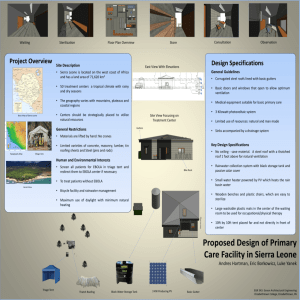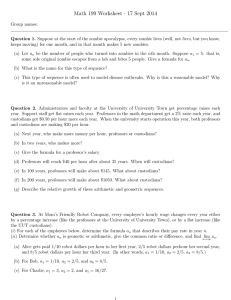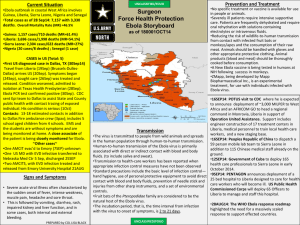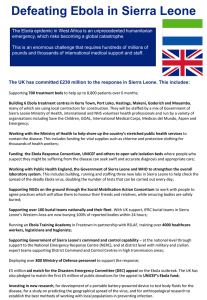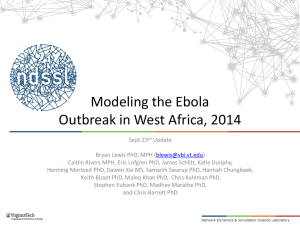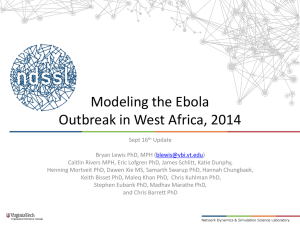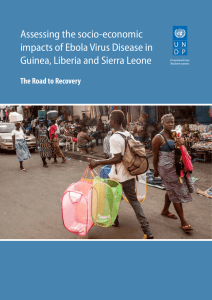WHO: Ebola Response Roadmap Situation Report 1 29 August 2014
advertisement
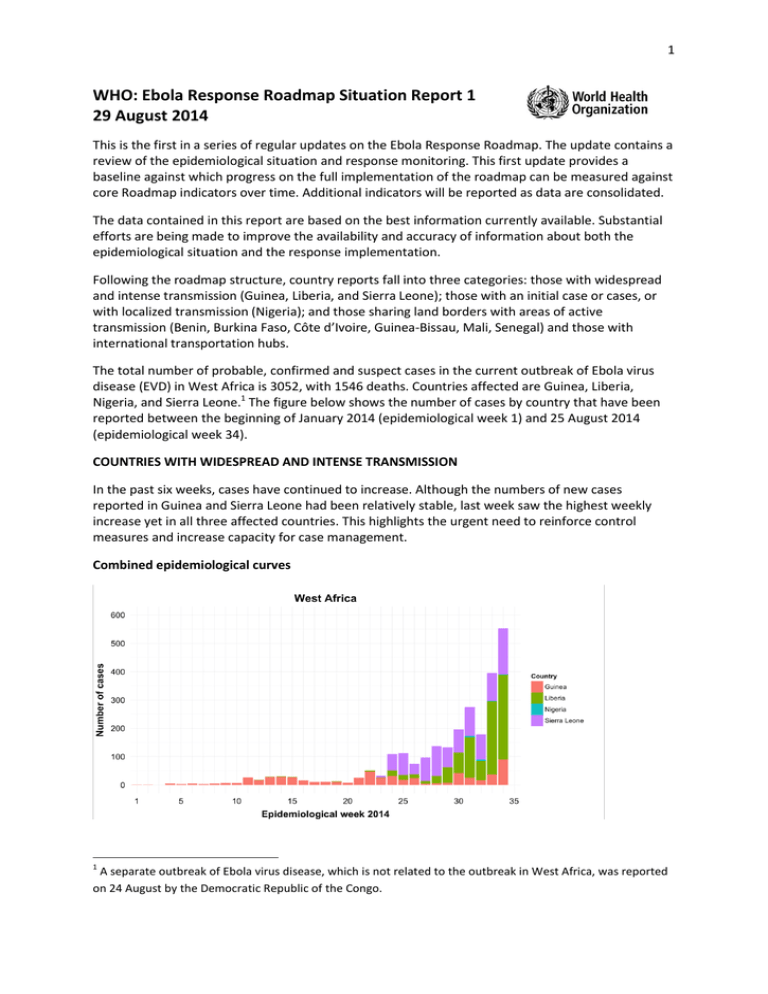
1 WHO: Ebola Response Roadmap Situation Report 1 29 August 2014 This is the first in a series of regular updates on the Ebola Response Roadmap. The update contains a review of the epidemiological situation and response monitoring. This first update provides a baseline against which progress on the full implementation of the roadmap can be measured against core Roadmap indicators over time. Additional indicators will be reported as data are consolidated. The data contained in this report are based on the best information currently available. Substantial efforts are being made to improve the availability and accuracy of information about both the epidemiological situation and the response implementation. Following the roadmap structure, country reports fall into three categories: those with widespread and intense transmission (Guinea, Liberia, and Sierra Leone); those with an initial case or cases, or with localized transmission (Nigeria); and those sharing land borders with areas of active transmission (Benin, Burkina Faso, Côte d’Ivoire, Guinea-Bissau, Mali, Senegal) and those with international transportation hubs. The total number of probable, confirmed and suspect cases in the current outbreak of Ebola virus disease (EVD) in West Africa is 3052, with 1546 deaths. Countries affected are Guinea, Liberia, Nigeria, and Sierra Leone.1 The figure below shows the number of cases by country that have been reported between the beginning of January 2014 (epidemiological week 1) and 25 August 2014 (epidemiological week 34). COUNTRIES WITH WIDESPREAD AND INTENSE TRANSMISSION In the past six weeks, cases have continued to increase. Although the numbers of new cases reported in Guinea and Sierra Leone had been relatively stable, last week saw the highest weekly increase yet in all three affected countries. This highlights the urgent need to reinforce control measures and increase capacity for case management. Combined epidemiological curves 1 A separate outbreak of Ebola virus disease, which is not related to the outbreak in West Africa, was reported on 24 August by the Democratic Republic of the Congo. 2 The figures below show the distribution of confirmed and probable cases in each of these countries, accompanied by numbers of cases over time in capital cities. GUINEA These data indicate that the reporting of cases in Guinea appears to have been relatively stable, but with a marked increase in the recent week. Priorities continue to be to reduce incidence in the epicentre (Gueckedou), and to address threatening foci in Conakry. LIBERIA By contrast, in Liberia, cases are increasing in the epicentre (Lofa) and in the capital, Monrovia. SIERRA LEONE The incidence of cases in Sierra Leone has been relatively flat, although with increases in the past week. Problems in scaling up response measures persist, notably in two districts, Kenema and Kailahun. Numbers of cases increased in the capital, Freetown. 3 The map below shows the location of cases throughout the countries with most intense transmission, differentiating the cumulative number of cases to date in each area, and the number occurring within the past 21 days (i.e. corresponding to the incubation period for Ebola). A full understanding of the outbreak that will lead to improved response requires detailed analysis of exactly where transmission is occurring (by district level), and of time trends. This analysis is ongoing. Preliminary results show that cases are still concentrated (62% of all reported cases since the beginning of the outbreak) in the epicentre of the outbreak, in Gueckedou (Guinea); Lofa (Liberia), where cases continue to rise; and Kenema and Kailahun (Sierra Leone). Capital cities are of particular concern, owing to their population density and repercussions for travel and trade. The outbreak continues to escalate. Over 40% of the total number of cases have occurred within the past 21 days. However, most cases are concentrated in only a few places. The overall case fatality rate is 51%. It ranges from 41% in Sierra Leone to 66% in Guinea. Total number of probable, confirmed and suspected cases and deaths in Guinea, Liberia and Sierra Leone 4 Note: Cases are classified as confirmed (any suspected or probable cases with a positive laboratory result); probable (any suspected case evaluated by a clinician, or any deceased suspected case having an epidemiological link with a confirmed case where it has not been possible to collect specimens for laboratory confirmation); or suspected (any person, alive or dead, suffering or having suffered from sudden onset of high fever and having had contact with: a suspected, probable or confirmed Ebola case, or a dead or sick animal; or any person with sudden onset of high fever and at least three of the following symptoms: headache, vomiting, anorexia/ loss of appetite, diarrhoea, lethargy, stomach pain, aching muscles or joints, difficulty swallowing, breathing difficulties, or hiccup; or any person with unexplained bleeding; or any sudden, unexplained death). COUNTRIES WITH AN INITIAL CASE OR CASES, OR WITH LOCALIZED TRANSMISSION To date, the only country with cases linked to a case imported from a country with widespread and intense transmission is Nigeria. The table below shows the distribution of cases in that country. Cases Deaths Case definition Total 21 days 21 days % Total 21 days 21 days % Confirmed 15 6 40% 6 4 67% 40% Probable 1 1 100% 1 0 0% 100% Suspected 3 3 100% 0 0 Total 19 10 53% 7 4 - CFR 0% 57% 37% The first 14 confirmed cases were all linked to persons, including health care workers, in close contact with an air traveller from Liberia, who entered Lagos on 20 July and died five days later. On 27 August, 1 additional case was confirmed in Port Harcourt by the Ministry of Health. A Ministry of Health and WHO team is in Port Harcourt supporting contact tracing and further investigation of the incident. 5 RESPONSE MONITORING The map below shows the availability of the six interventions that are necessary to control Ebola in the countries with most intense transmission. Work is ongoing to fully assess the coverage and quality of each intervention in the affected areas. Disclaimer: Most of the analysis contained in this report is based on secondary data analysis from multiple sources. It has 2 not yet been possible to verify all of this information. Updates will be provided as more information becomes available. 2 Sources of information include: WHO and Ministries of Health reports, OCHA 3 W matrix and maps, reports from UNICEF Conakry and Geneva, situation reports from NGOs (IMC) and communications with other partners and foreign medical teams. 6 Case management and infection prevention and control There are serious problems with case management and infection prevention and control. The situation is worsening in Liberia and Sierra Leone. In Guinea, the capacity to manage the current load of EVD cases is currently adequate in Gueckedou and in Conakry. In Liberia, the capacity to cope with the increasing caseload remains dramatically low, especially in the capital, Monrovia, as well as in Bong and Nimba counties. In Nigeria, a 40-bed isolation unit has been set up in the Mainland Hospital, and is sufficient to accommodate the patients currently isolated. The Ministry of Health has set up an isolation unit in Lagos town to care for cases. In Sierra Leone, there is inadequate capacity to accommodate patients in Freetown. Patients must be transferred to Kenema, which is already overwhelmed by local demand. Health care workers continue to be seriously affected in all countries, especially in Liberia and Nigeria. Laboratory capacity In Guinea, laboratory capacity currently appears to be sufficient. Support is being provided by the Pasteur Institute Dakar in Conakry, the European Union Mobile Laboratory in Gueckedou, and WHO. In Liberia, specimens from Lofa county are tested in Guinea. Additional laboratory support is needed in Lofa to alleviate this burden. Specimens from other counties far from Lofa are sent to Monrovia, where laboratory capacity, supported by the United States Army Medical Research Institute of Infectious Diseases, US National Institutes of Health, and US Centers for Disease Control and Prevention, is stretched. The need for more laboratory support is being assessed in Bong (Pheebe hospital), Nimba and Bomi counties. In Sierra Leone, additional laboratory support is needed in addition to the Kenema laboratory (supported by Metabiota and the US Department of Defense Critical Reagent Team) to cope with the increasing disease burden. A mobile laboratory from South Africa has been deployed to Freetown, where Ebola treatment centres are being constructed to care for patients locally and in better conditions, rather than referring them to Kenema. In Nigeria, the Lagos University Teaching Hospital virology lab and the Lagos University Laboratory are being supported by WHO and an EU mobile team from the WHO Collaborating Centre in Hamburg, Germany. COUNTRIES SHARING LAND BORDERS WITH AREAS OF ACTIVE TRANSMISSION AND THOSE WITH INTERNATIONAL TRANSPORTATION HUBS The following countries share land borders or major transportation connections with the affected countries and are therefore at risk for spread of the Ebola outbreak: Benin, Burkina Faso, Côte d’Ivoire, Guinea-Bissau, Mali, and Senegal. 7 WHO and a range of partners are working with countries to ensure that full Ebola surveillance, preparedness and response plans are in place in these countries. Priority activities include activation of active surveillance for clusters of unexplained death due to fever, provision of appropriate information and advice to the general public and travellers; identification of an isolation unit; verified access to a WHO-recognized laboratory; and the establishment of a strategy for identifying and monitoring contacts of any suspected case.
